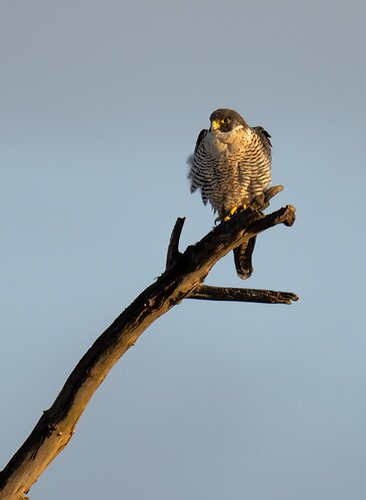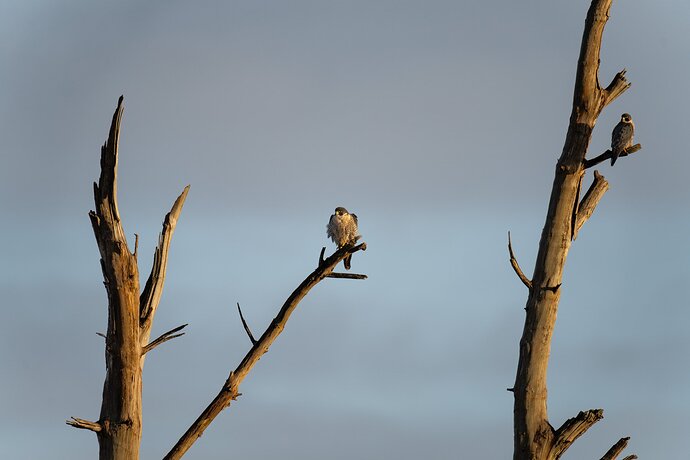raw image
Description: these two Peregrine falcons were hanging out at my local wildlife refuge. I was fortunate enough to get there early enough to watch them for at least an hour before they flew away. And they are very fast.
Specific Feedback Requested: I really wish I could get closer to my subjects. I suppose that is the wish of every avian bird photographer for the most part. Image quality is everything and these very large crops leave something to be desired. I have played around with Topaz gigapixel AI but find that it has a tendency to smear parts of the image. I have the same issue with Topaz AI clear. Even with a sharp lens, the distance to the subject and that 2X extender probably contribute to less acceptable image quality. The software is getting better but it’s not there yet.
Pertinent technical details or techniques: iso 800, 400 plus 2X, f5.6, 2500th, A7R4, handheld.
first image is 4.4 out of 61 MP or 3.7% of full frame, second image is 30% of full frame or 19.5 out of 61 MP.
If you would like your image to be eligible for a feature on the NPN Instagram (@NaturePhotoNet), add the tag ‘ig’ and leave your Instagram username below.
Those peregrines are sweet–the female is huge compared to the male. You are correct, the teleconverter loses a lot of micro-contrast which is very essential in bird photography. I bump up the sizes of a lot of my images using the export feature in Lightroom. Now that you know where this couple like to hang out, you may just have to wait for the right opportunity. Go with a tripod and a cable release–at 800mm, you’d be amazed how much everything vibrates before you take the shot. …Jim
Yes I am well aware of the vibration at 800 mm. Although this image was handheld, I have been using a lightweight travel tripod to reduce some of the baggage. I don’t see a whole lot of difference in image quality between the handheld images and those that I take with a tripod. When I do use a tripod, I brace it from the back and the lens shade to reduce vibration. And in addition I shoot at a minimum of 2500th. What I don’t know is the effect of the Sony in body and lens vibration reduction algorithms.
1 Like
Quite nice, actually, David. I agree that there’s a problem at that refuge-all the perches that this kind of bird likes are a long way from anywhere a photographer can get. Have you tried using just the electronic shutter? Mirrorless helps a lot, but the shutter itself is going to induce some vibration and just the fact of the distance is going to make it impossible to get single pixel sharpness-nothing’s that stable.
Overall, nicely done. I’m lucky to see the occasional one, let alone two. I particularly like the tree on the left and wonder how it would look with the tree on the right cropped out.
I think that is pretty amazing David to get two Peregrine Falcons in one shot. It is tough sometimes when you can’t get closer but they are still very good shots. I like the warm glow to the light and the snarly bare snacks the birds are perched on. I could see a crop of just the left hand bird in bottom photo and all of the snag. The longer the better to emphasis the height I suppose. Or even a pano crop of that same bird but including the top of left part of snag. I like the character in that old tree and the red glow.
I love the opportunity you had here! And that snag on the left speaks to me.
It’s not easy to modify light, but I wonder if you have tonal leeway to dig into the darks a bit more?
I sometimes shoot at 1200 (600 f/4 + 2X) and have done 1680 (adding the 1.4X by using the 12mm extension tube to interface the 2 TCs). With my big RRS tripod and Wimberley II head, and the “older meaning” of a lockdown, I can get technically sharp images, but the most limiting factor is atmospheric disturbance, especially near water. Even if it is cold, it hardly seems to help. Anywhere near the ocean, don’t even bother.


